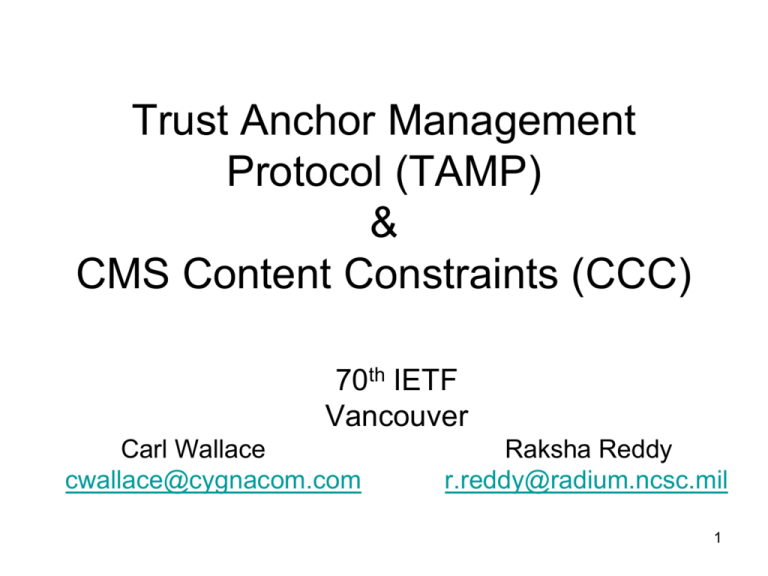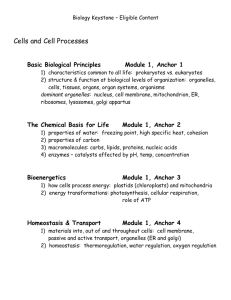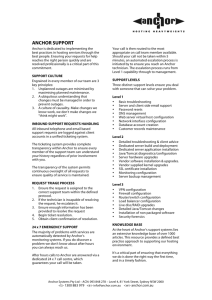Trust Anchor Management Protocol (TAMP) & CMS Content
advertisement

Trust Anchor Management
Protocol (TAMP)
&
CMS Content Constraints (CCC)
70th IETF
Vancouver
Carl Wallace
cwallace@cygnacom.com
Raksha Reddy
r.reddy@radium.ncsc.mil
1
Agenda
• Trust Anchor Management Problem Statement
– http://www.ietf.org/internet-drafts/draft-wallace-tamgmt-problem-statement-02.txt
• TAMP overview
– http://www.ietf.org/internet-drafts/draft-housley-tamp00.txt
• CCC overview
– http://www.ietf.org/internet-drafts/draft-housley-cmscontent-constraints-extn-00.txt
• Q&A
2
What are trust anchors?
• Trust anchors (TAs) are trusted public keys with
with associated information
– Used for signature verification
– Associated information varies with TA purpose
• RFC3280 requires issuer name, public key algorithm, public
key and optionally, the public key parameters associated with
the public key to support certification path validation
• TAs are used for various purposes
– Certification path validation
– Verification of signed objects, including firmware,
timestamps, OCSP responses, keys, etc.
• TAs are maintained in trust anchor stores, which
are sets of one or more trust anchors
3
Problem statement
• There is currently no standard mechanism for managing
trust anchor stores
– Proprietary means abound
– Remote management can be difficult (and is generally beyond
the reach of PKI policy authorities)
– Some application-specific standards are being developed (draftietf-dnsext-trustupdate-timers)
• No standard representation for trust anchors
– Self-signed certificates are a de facto means of installing names
and keys for use with PKI
• However, self-signed certificates do not provide hooks for TA
management
– Uniform representation may not be necessary even if common
management means are used
4
General Proposal
• Define a protocol for managing trust anchor
stores
– Generic trust anchor representation requirements
include trust anchor name, public key information and
trust anchor usage
– Enable add/remove/query operations on trust anchor
stores
• Primary aim is to reduce reliance on out-of-band
trust mechanisms
– After initial trust anchors have been installed, out-ofband means should not be necessary
5
TAMP Summary
• Eleven message formats
– Five request/response pairs
– TAMPError message
• All request messages signed; all response
messages optionally signed
• Uses CMS SignedData for message integrity
• Trust anchor (TA) privileges defined and
enforced using CMS Content Constraints (CCC)
• TAs represented using TrustAnchorInfo structure
6
Trust anchor types
• Three types: Apex, Management, Identity
• Apex trust anchor
– One per trust anchor store
– Superior to all other trust anchors; Unconstrained
– Different structure than other trust anchors. Includes
two public keys: operational and contingency
• The operational key is used in same manner as other trust
anchors
• The contingency key can only be used to update the apex
trust anchor. It is distributed in encrypted form. Single use.
• Contingency key is useful if operational key is compromised
or lost
• Contingency key may use a different algorithm than
operational key
7
Trust anchor types (continued)
• Management trust anchors
– Enable authorization checking for
management messages
• Where management messages are authenticated
using CMS (primarily focused on RFC 4108, TAMP
and draft-ietf-keyprov-symmetrickeyformat)
• Identity trust anchors
– Used to validate certification paths
– Generally associated with non-management
applications
8
·
·
Apex trust
anchor
·
·
Trust Anchor
Relationships
·
·
·
·
Management
TAs or CAs
Identity TAs or
CAs
·
Signed Objects
per TA
definition
One per trust anchor store
Represented as a trust anchor only (no
certificates)
Initial Apex TA add during store initialization
Contains two keys: operational and
contingency
Managed via Apex Trust Anchor Update
messages which must be validated using
operational key or contingency key
Zero or more per trust anchor store
May be represented as Trust Anchor or
public key certificate
Trust anchor instances are managed via
Trust Anchor Update messages which must
be validated using public key authorized for
TAMP
Certificate instances must validate to a trust
anchor authorized to issue certificates
End entity
certificates
9
TrustAnchorInfo
TrustAnchorInfo ::= SEQUENCE {
version
[0] TAMPVersion DEFAULT v2,
pubKey
PublicKeyInfo,
keyId
KeyIdentifier,
taType
TrustAnchorType,
taTitle
TrustAnchorTitle OPTIONAL,
certPath CertPathControls OPTIONAL }
• taType indicates the type of trust anchor
– ApexTrustAnchorInfo, MgmtTrustAnchorInfo or NULL
• taTitle is human readable name for the trust anchor
• certPath provides the controls needed to initialize an X.509
certification path validation algorithm implementation
– When absent, TA cannot be used to validate certificates
• New structure aims to help minimize size by avoiding fields in
certificates that are not processed during validation
10
ApexTrustAnchorInfo
ApexTrustAnchorInfo ::= SEQUENCE {
continPubKey ApexContingencyKey,
seqNum
SeqNumber OPTIONAL }
ApexContingencyKey ::= SEQUENCE {
wrapAlgorithm AlgorithmIdentifier,
wrappedContinPubKey OCTET STRING }
SeqNumber ::= INTEGER (0..9223372036854775807)
attribute used to convey decryption key
id-aa-TAMP-contingencyPublicKeyDecryptKey
OBJECT IDENTIFIER ::= { id-attributes 63 }
--
PlaintextSymmetricKey ::= OCTET STRING
11
ApexTrustAnchorInfo (continued)
ApexTrustAnchorInfo ::= SEQUENCE {
continPubKey ApexContingencyKey,
seqNum
SeqNumber OPTIONAL }
• ApexTrustAnchorInfo appears in the taType field of TrustAnchorInfo
– Carries the contingency key and optional sequence number
• continPubKey is the encrypted contingency key
– When decrypted, yields a PublicKeyInfo structure
– Decrypted using the contingencyPublicKeyDecryptKey attribute
• Appears as an unsigned attribute on messages that are verified using the
contingency key
• seqNum can be used to set the initial sequence number value
associated with the operational public key in the encapsulating
TrustAnchorInfo
12
MgmtTrustAnchorInfo
MgmtTrustAnchorInfo ::= SEQUENCE {
taUsage TrustAnchorUsage,
seqNum
SeqNumber OPTIONAL }
TrustAnchorUsage ::= CMSContentConstraints
CMSContentConstraints ::= ContentTypeConstraintList
ContentTypeConstraintList ::= SEQUENCE SIZE (1..MAX)
OF ContentTypeConstraint
ContentTypeConstraint
contentType
canSource
attrConstraints
::= SEQUENCE {
ContentType,
BOOLEAN DEFAULT TRUE,
AttrConstraintList OPTIONAL }
AttrConstraintList ::= SEQUENCE SIZE (1..MAX) OF
AttrConstraint
13
MgmtTrustAnchorInfo(continued)
MgmtTrustAnchorInfo ::= SEQUENCE {
taUsage TrustAnchorUsage,
seqNum
SeqNumber OPTIONAL }
• MgmtTrustAnchorInfo appears in the taType field of
TrustAnchorInfo
– Carries the CCC privileges for the TA and optional
sequence number
• taUsage identifies the types of CMS contents the TA can
be used to verify
• seqNum can be used to set the initial sequence number
value associated with the public key in the encapsulating
TrustAnchorInfo
14
TAMPMsgRef
TAMPMsgRef ::= SEQUENCE {
target TargetIdentifier,
seqNum SeqNumber }
• TAMPMsgRef is used to target TAMP messages
and to indicate sequence number
– Target identifies the trust anchor stores or community
of stores that are the target of a message
• Can target all recipients, specific hardware types or instances
or via community identifiers
– Sequence number is a single use value that can be
used to match request and response messages
15
Targeting trust anchor stores
• TAMP enables the generation of very
targeted trust anchor management
messages
– Allows generation of messages targeting a
specific trust anchor store
• Community identifiers allow trust anchor
stores to be aggregated into groups
– Groups created and managed using TAMP
messages
16
TAMPStatusQuery and
TAMPStatusResponse
TAMPStatusQuery ::= SEQUENCE {
Version [0] TAMPVersion DEFAULT v2,
terse
[1] TerseOrVerbose DEFAULT verbose,
query
TAMPMsgRef }
TerseOrVerbose ::= ENUMERATED { terse(1),verbose(2)}
• Enables list of trust anchors resident in a trust store to be requested
and returned
– Terse responses list key identifiers only
– Verbose responses provide list of TrustAnchorInfo structures
17
TrustAnchorUpdate
TAMPUpdate ::= SEQUENCE {
version [0] TAMPVersion DEFAULT v2,
terse
[1] TerseOrVerbose DEFAULT verbose,
msgRef
TAMPMsgRef,
updates SEQUENCE SIZE (1..MAX) OF
TrustAnchorUpdate }
TrustAnchorUpdate ::= CHOICE {
add
[1] EXPLICIT TrustAnchorInfo,
remove [2] PublicKeyInfo,
change [3] TrustAnchorChangeInfo }
• Includes a TrustAnchorInfo to add to the store, identifies a trust
anchor to remove by public key or presents new details to replace
those associated with a key already present in a trust store
• Each operation is subject to subordination checks
18
TrustAnchorUpdateConfirm
TAMPUpdateConfirm ::= SEQUENCE {
version [0] TAMPVersion DEFAULT v2,
update
TAMPMsgRef,
confirm UpdateConfirm }
UpdateConfirm ::= CHOICE
terseConfirm
[0] StatusCodeList,
verboseConfirm [1] VerboseUpdateConfirm }
VerboseUpdateConfirm ::= SEQUENCE {
status
StatusCodeList,
taInfo
TrustAnchorInfoList }
• Returns status of an update operation one of two way
– As a list of status codes (one per element in the update message)
– As a list of status codes and TAs (represents state following update)
19
TAMPApexUpdate and
TAMPApexUpdateConfirm
TAMPApexUpdate ::= SEQUENCE {
version
[0] TAMPVersion DEFAULT v2,
terse
[1] TerseOrVerbose DEFAULT verbose,
msgRef
TAMPMsgRef,
clearTrustAnchors BOOLEAN,
clearCommunities
BOOLEAN,
apexTA
TrustAnchorInfo }
• Verified using either operational or contingency key
• Replacement information carried in apexTA field
• If clearTrustAnchors is TRUE, then all management and identity TAs
must be deleted leaving on the newly installed apex TA
• If clearCommunities is TRUE, then all community identifiers must be
deleted, leaving none
• TAMPApexUpdateConfirm (not shown) can return single status code
value (terse) or a status with a list of all TAs and communities
(verbose)
20
Other types
• TAMPCommunityUpdate allows community identifiers to
be added or removed from the list of communities
maintained by a trust anchor store (i.e., the communities
to which the store belongs)
– Terse and verbose response types
• SequenceNumberAdjust can be used to provide the
most recently used sequence number to one or more
stores
– Reduces possibility of replay
– Response simply includes a status code indicating the success
or failure of the sequence number adjust message processing
21
CCC Summary
• Used to restrict the types of CMS protected objects that
can be verified using a particular public key
• Expressed as permitted content types and constraints on
attribute values
• Privileges represented as either a TrustAnchorInfo field
or as a certificate extension
– Privileges for a particular content originator are output from
certification path validation (intersection of CCC values in path)
• Object type represented by CMS content type OID
– Object attributes collected by processing authenticated layers in
a CMS message
– Each party collaborating to produce a signed or authenticated
content must be authorized for the innermost content types and
attribute values
22
CMS Paths
+---------------------------------------------------------+
| ContentInfo
|
| +-----------------------------------------------------+ |
| | SignedData
| |
| | +-------------------------------------------------+ | |
| | | ContentCollection
| | |
| | | +----------------------+ +--------------------+ | | |
| | | | SignedData
| | SignedData
| | | |
| | | | +------------------+ | | +----------------+ | | | |
| | | | | EncryptedData
| | | | Firmware
| | | | |
| | | | |
| | | | Package
| | | | |
| | | | | +--------------+ | | | |
| | | | |
| | | | | | Firmware
| | | | +----------------+ | | | |
| | | | | | Package
| | | +--------------------+ | | |
| | | | | |
| | |
| | |
| | | | | +--------------+ | |
| | |
| | | | +------------------+ |
| | |
| | | +----------------------+
| | |
| | +-------------------------------------------------+ | |
| +-----------------------------------------------------+ |
+---------------------------------------------------------+23
CMS Paths (continued)
ContentInfo
|
|
V
SignedData
|
V
ContentCollection
|
+----------+--------------+
|
|
V
V
SignedData
SignedData
|
|
V
V
EncryptedData
FirmwarePackage
|
V
FirmwarePackage
24
CMS Paths (continued)
• Two types of leaf nodes: encrypted leaf
nodes and payload leaf nodes
– Encrypted leaf nodes are one of the following
types: EncryptedData, EnvelopedData or
AuthEnvelopedData
– Payload lead nodes are all other leaf node
types (non-encrypted CMS types like
SignedData, ContentCollection, etc. are not
leaf nodes)
25
Subject permissions
• Identify the types of leaf nodes for which a
subject can serve as originator or collaborator
– Constrain attribute values a subject can use for
particular types of leaf nodes
• Collected and evaluated during path processing
– Content type and attributes collected from CMS path
are provided as input
– Constraints are collected from trust anchor and
intersected with certificate-based constraints and
evaluated during validation wrap-up
– Default attributes are returned along with constraints
for the input content type
• Constraints may be used when processing the content
26
Object type and attributes
• Public keys and signed or authenticated
attributes are collected from a CMS path
– For encrypted leaf nodes, these are simply returned
and may be used for further processing
– For payload leaf nodes, a path is validated to each
public key providing the object type and attributes as
input
• Each public key must be authorized for object type and each
attribute value
• Public key used to verify the signature or MAC closest to the
payload leaf node must be authorized as a source for the
object type
27
Summary
• Use TAMP to manage TAs and associated
CMS-focused privileges
• Use CCC to express and enforce CMS-focused
privileges
• Use RFC4108 and draft-ietf-keyprovsymmetrickeyformat to package firmware and
keys with source authentication controlled by
TAMP and CCC
• CCC could be useful for other CMS-protected
payloads
– Attributes give flexibility beyond extendedKeyUsage
28








